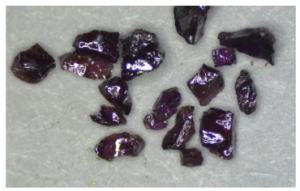Context: The scientific community found that the LK-99 material is not a room-temperature and ambient-pressure superconductor.
More on News:
- Recently, a South Korean team of experts posted two papers claiming that they had synthesized the world’s first room-temperature superconducting material under ambient pressure.
- There has been no formal conclusion that this material was a superconductor. The majority of experts hold doubts regarding the Korean researchers’ findings.
 Researchers from the National Physical Laboratory of India shared their papers concluding that LK-99 does not exhibit superconductive properties.
Researchers from the National Physical Laboratory of India shared their papers concluding that LK-99 does not exhibit superconductive properties.- LK-99 Compound:
- LK-99 is a modified-lead apatite crystal structure doped with copper.
- It is a gray–black, polycrystalline compound.
- The material has been analyzed at Vienna with computer simulations which discovered that the calculated electron states are indeed quite favorable for superconductivity.
About Superconductivity:
Absolute Zero Temperature
- Often denoted as 0 Kelvin or minus 273.15°C, it is the lowest possible temperature that can theoretically exist in the universe according to the laws of thermodynamics.
- At absolute zero, the motion of all particles and atoms in a substance would come to a complete standstill, resulting in the minimum possible energy state.
- Cryogenics: The study of extreme low temperatures and the behavior of materials near absolute zero.
|
- Superconductivity: It is a physical phenomenon in which certain materials, when cooled to very low temperatures, usually near absolute zero, exhibit zero electrical resistance and expel magnetic fields.
- Critical Temperature: The temperature at which the electrical resistivity drops to zero is known as critical temperature.
- Discovery: Superconductivity was first discovered in 1911 by Heike Kamerlingh Onnes when he observed the sudden loss of electrical resistance in mercury at extremely low temperatures.
- Zero Resistance: In a superconductor, electric current can flow without any resistance, meaning that once a current is initiated, it can circulate indefinitely without dissipating energy as heat.
- Different from Conductors: This behavior is fundamentally different from that of regular conductors, which have resistance and thus lose some energy as heat when carrying an electric current.

Applications of Superconductivity:
- Medical Imaging Systems: Superconducting magnets are a crucial component of Magnetic Resonance Imaging (MRI) machines, strong and stable magnetic fields produced by superconducting magnets improve the quality of MRI scans.
- Superconducting Quantum Interference Devices (SQUIDS): Superconducting qubits are used in some quantum computing platforms to perform quantum computations. These devices offer the potential for solving complex problems faster than classical computers.
- Particle Accelerators: Superconducting magnets are used in particle accelerators to generate strong magnetic fields for controlling and focusing particle beams. This is essential for high-energy physics experiments and research into fundamental particles.
- Levitated Vehicle Transportation: Superconducting magnets allow MagLev trains to levitate above the tracks. This eliminates friction between the train and the tracks, enabling high-speed, energy-efficient transportation. For example, Japan is currently experimenting with MagLev tracks.
- Fusion Reactors: Superconducting magnets are used in experimental fusion reactors, such as tokamaks, to confine and control the hot plasma needed for nuclear fusion. For example, Tokmak energy built the first super magnets for testing in nuclear plants.
- Communication Systems: Superconducting filters and detectors are used in communication systems, especially for satellite communication, due to their high sensitivity and low noise characteristics.
- Military and Defense Applications: Superconductors have potential military applications, including highly sensitive sensors for detecting submarines, advanced radar systems, and more.
India and Superconductivity
- National Superconductivity Mission 2017:
- It aims to promote research and development in the field of superconductivity.
- The mission is to develop indigenous technology for superconductors.
- It is being implemented by the Department of Science and Technology in collaboration with the Department of Atomic Energy and the Council of Scientific and Industrial Research (CSIR).
- Tata Institute of Fundamental Research and IIT Bombay are leading research in superconductivity in India.
|
Challenges Associated with Superconductivity
- Cryogenic Cooling: Cooling superconducting materials to cryogenic temperatures requires specialized cooling systems.
- Technical Expertise: Working with superconducting materials requires specialized technical knowledge and skills, which may limit their adoption in industries with less familiarity in this area.
- Costs: Superconducting materials and their associated technologies can be expensive to develop, produce, and operate.
- Brittleness: Some superconducting materials are brittle and can be challenging to fabricate into practical devices.
- Materials Performance Variability: The performance of superconducting materials can vary, which can impact the reproducibility and reliability of devices.
Conclusion
With the bleeding edge of research, we are delving deeper into High-Temperature superconductivity and trying to understand its cause. The mystery behind the formation of electron pairs will definitely fetch a Nobel Prize. Room-temperature superconductors with desired materials will allow us to commercialize scientific prototypes and open new avenues.
News Source: The Hindu
![]() 19 Aug 2023
19 Aug 2023
 Researchers from the National Physical Laboratory of India shared their papers concluding that LK-99 does not exhibit superconductive properties.
Researchers from the National Physical Laboratory of India shared their papers concluding that LK-99 does not exhibit superconductive properties.